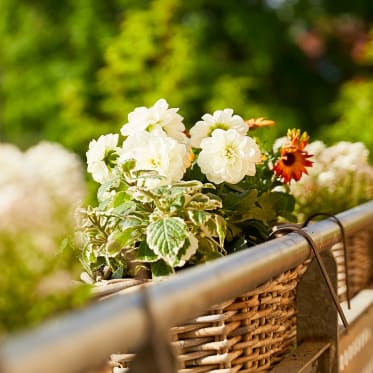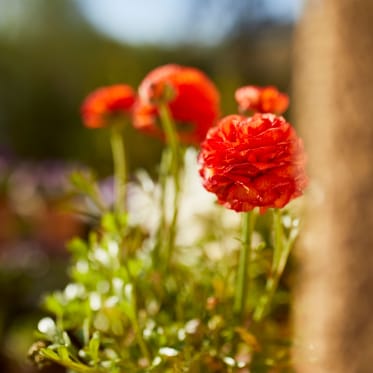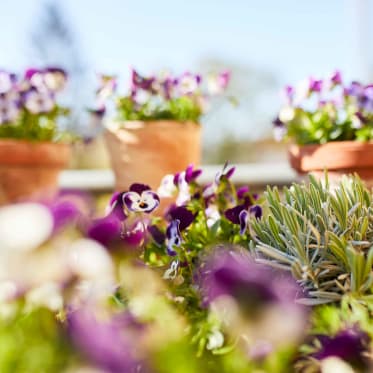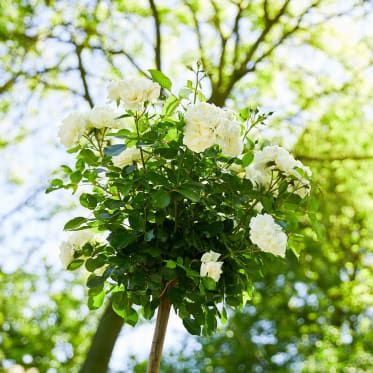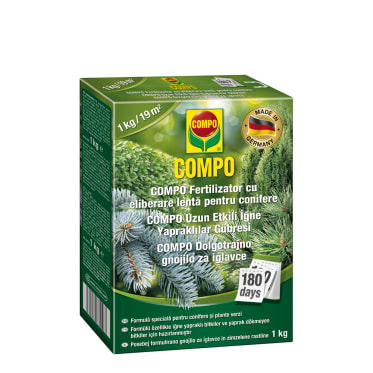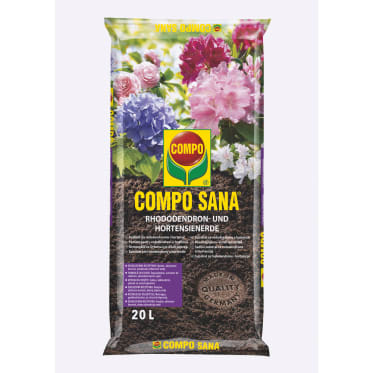Frequent search terms

- COMPO
- Guide
- Plant Care
- Balcony and potted plants
- Buying and caring for a potted Christmas tree
Letting it reach a ripe old age
Buying and caring for a potted Christmas tree
The life of a tree for a week or two of candles and tinsel? Although the Christmas tree enjoys a long tradition in our country, it and many others will be outside on the pavement when the refuse collection date arrives at the latest. A small potted Christmas tree is a sustainable alternative. But to ensure the tree survives the festive season in a warm living room, there's a few things that you need to consider. We show you how to get many years of enjoyment from your potted Christmas tree.
Table of content
The sustainable Christmas tree alternative
O Christmas Tree
In addition to looking wonderful, a potted Christmas tree cared for properly lasts much longer and is thus more sustainable than one that has been felled. The little tree even saves you a lot of work when it comes to cleaning up. For example, the potted Christmas tree comes with a root ball, which means it loses far fewer needles than a felled tree. The Christmas tree in a container can also be used in a variety of ways, as the generally smaller trees are also ideal as natural Christmas decorations in small flats or on the balcony or patio.
But if you would like to buy a potted conifer for Christmas, you should also consider the drawbacks. This variant means that you usually have to make do with a small tree measuring no more than 1.20 m. Larger conifers are not suitable for growing in a pot because of their size and weight. The tree also needs the appropriate care to stay healthy for a long time. Below is a summary of the most important care steps that should be taken before and after your Christmas tree has been decorated.

Classic fir or rather a spruce?
Choosing the right variety
If you want to buy a sustainable potted Christmas tree, the first thing you need to do is decide what kind of tree should decorate your living room. Firs are especially popular in this part of the world – so much so that in addition to referring to the species, the term 'fir tree' is usually a synonym for 'Christmas tree'.
Thanks to its beautiful dark green needles, the Nordmann fir is by far the most popular Christmas tree in this country. But since the fir forms deep vertical roots and becomes quite large, keeping it in a pot can prove quite difficult. When growing in a pot it is advisable to opt for a compact, low-growing species of fir. For example, dwarf Korean firs are perfect because they grow very slowly. Accordingly, this mini tree generally reaches a height of no more than 80 cm. And thanks to the pretty, blue-violet hue of its cones, the dwarf fir is a real eye-catcher over the festive season! On the other hand, the small Norfolk Island pine (Araucaria heterophylla), is a great solution if you don't want to do without a classic fir at Christmas. This pretty potted conifer reaches a height of one to two metres. The advantage here is that since the fir has been bred specifically for use as a houseplant, it can remain indoors permanently and is much easier to care for than other plants of the same species.
But apart from the well-known firs, you also have a wide variety of spruces to choose from for your sustainable potted Christmas tree. The advantage of the spruce is that since this conifer has a fibrous root system, it can adapt better to its environment in a pot and therefore copes well with little space. Thanks to its dense growth habit, the white spruce cuts an especially good figure at Christmas. The slow-growing tree only reaches its final height of two to three metres after several years. Having said that, the white spruce is very small at first, making it ideal for use as a potted Christmas tree in the living room.
Things to watch for
Buying a potted Christmas tree
To guarantee your rooted Christmas tree can become a sustainable project for many years to come, you should make sure it has a firm root ball and many fine fibrous roots when you buy it. Accordingly, choose a specimen that has been grown in a pot rather than one that has been dug up and then planted in a container. These often have damaged roots and are not able to survive. In particular, the transition from cold garden to warm living room and back entails stresses that only a strong and healthy conifer with well-developed, intact roots can withstand. If you want to check, carefully pull the tree out of the pot before you buy it. If its root ball is well-developed and compact, then you can go to the checkout without thinking twice. To make it easier to plant the tree in the garden later on, you should choose a smaller specimen because smaller plants usually withstand the transplant shock better than larger conifers that have become accustomed to a permanent location over years of development. This means that young, smaller plants that have been grown in a pot for about a year are ideal.

Heat stroke and cold shock
Give the Christmas tree a period of acclimatisation
Since a Christmas tree is in a dormant state during the festive season of all times, it needs a period of acclimatisation before being put into a warm living room. It is advisable to put it in a sheltered, bright spot for several days, for example on a patio or balcony. An unheated hallway or a bright garage is also well suited for this. Nevertheless, since the move back outdoors can present a risk once the plant is accustomed to warm and cosy temperatures, you should keep its stay indoors as short as possible. That's why it's advisable to move your potted fir into the living room one day before Christmas and then release it back into the wild before New Year's Eve, so that it does not spend more than ten days indoors in the warmth. You can also do a lot for the health of the tree by putting it up in the coolest possible location. A conservatory, for example, is ideal. On the other hand, the fireplace and radiators do not make good neighbours for your tree.
Arid living room desert
Water the potted Christmas tree regularly
As long as it doesn't freeze, it's a good idea to water the Christmas tree thoroughly before moving it indoors so as to prepare it for the warm air from your heating system. During its stay indoors, the conifer should be included in your watering routine for indoor plants – under no circumstances should the root ball be allowed to dry out. Test the soil with a finger and water it if the surface feels dry. Having said that, conifers cannot tolerate waterlogging. If your potted Christmas tree loses its needles and turns yellow, this may be an indication that the soil and thus roots are too moist. To make the conifer's time as a Christmas tree especially pleasant, spray its needles with water every one to two days – this has a cooling effect and increases humidity.
Back to freedom
Moving the potted Christmas tree outdoors
It's important to allow the small Christmas tree sufficient time to acclimatise when you move it outdoors, too. It's advisable to move the tree to the hallway or garage again to allow it to spend a few days in the place where it was acclimatised for its stay indoors. Regular watering should be continued for a while to allow the Christmas tree to compensate for losses due to the evaporated moisture. After about two weeks, you can put the potted Christmas tree in a sheltered spot outdoors in frost-free weather. If you want to plant your potted Christmas tree in the garden, it's advisable to wait until the spring when any risk of the soil freezing has passed.
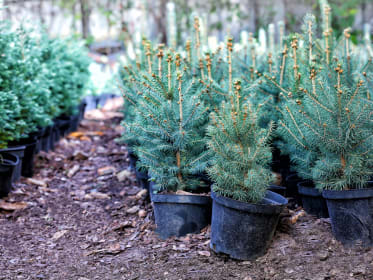
Tips for proper care
Caring for and repotting a potted fir after Christmas
The next Christmas is never more than a year away! If you want to reuse your Christmas tree for the next few years, you can put it outside for several years and grow it there in the pot. It's important that you repot the conifer in a larger container at regular intervals – ideally every two to three years – so that it has enough space to grow. Conifers favour acidic soil, such as rhododendron and hydrangea soil. Continue to provide sufficient water. In the case of potted plants, in particular, it is crucial to avoid waterlogging but at the same time not to let the root ball dry out. An additional layer of pumice stone in the bottom of the container will ensure optimum drainage and thus improve water conductivity in the pot.
To supply your potted Christmas tree with all the necessary nutrients, work a special conifer fertiliser, such as the 'COMPO Koniferen Langzeit-Dünger' slow release conifer fertiliser, into the soil immediately when planting or at the beginning of the growing season in the spring.
Into the garden
Planting and caring for Christmas trees
If you have the necessary space in your garden and want to share your coniferous tree with other garden residents, plant your potted Christmas tree outside in the spring after the last frosts. This will give the tree the chance to live for several decades. After three to four years at the latest, the fir tree is likely to be too big to be kept in a pot. To plant the fir tree outside, it is advisable to dig a planting hole that is at least twice the size of the plant's root ball. Then carefully loosen the tree's roots when you lift it out of the pot and put the woody plant in the hole in the ground. After that, put the soil around the root ball and press it down well. You should then water the tree regularly – especially if spring isn't rainy and wet. Digging your conifer out of the ground for Christmas and then replanting it in a pot is not advisable because you inevitably run the risk of damaging the tree's roots.
Other sustainable topics
Suitable products for your potted Christmas tree





